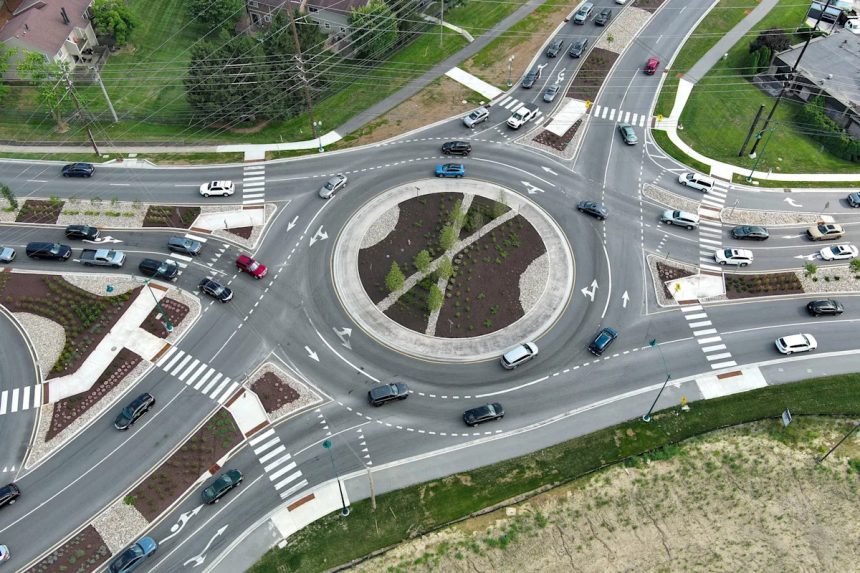If you’re new to Indiana or just passing through, you need to know how to navigate a roundabout. Some cities have a lot of them.
While most of the state’s roundabouts are located in Central Indiana, primarily in Hamilton County, they have been implemented statewide.
Here’s what drivers need to know.
What is a roundabout?
According to the Indiana Department of Transportation, a roundabout is “a circular intersection or junction in which road traffic flows almost continuously in one direction around a central island.”
How do you navigate a roundabout?
Here’s how to navigate a roundabout according to INDOT:
-
Approach:
-
Slow down and stay in your lane
-
Yield to vehicles already in the roundabout
-
Obey one-way signs at all times
-
Yield to pedestrians and bicycles if there is a crosswalk
-
-
Enter:
-
Merge with traffic in the roundabout, yield if necessary. Traffic already in the roundabout has the right of way.
-
-
Proceed:
-
Continue through the roundabout until you reach your exit point. Avoid stopping in the roundabout
-
-
Exit:
-
Signal and exit to the right
-
Left turns are completed by circling around the center island and then making a right turn to exit
-
Roundabouts can accommodate emergency and large-sized vehicles. Even in a roundabout, proceed like you would on any roadway if you see an emergency vehicle. Move as far right as possible and, if necessary, stop until the emergency vehicle passes.
Cars enter a roundabout Wednesday, July 23, 2025, at the intersection of 96th Street and Allisonville Road in Fishers.
How many times can you go around a roundabout?
If you miss your exit when in a roundabout, you can always go around again instead of cutting someone off. In Indiana, there is no legal limit to the number of times you can go around a roundabout. But if you decide to do go around too many times (i.e. until you’re dizzy and/or run out of gas), you could potentially cause an accident and find yourself charged with reckless driving.
How many roundabouts are in Hamilton County?
There are 248 roundabouts in Hamilton County, according to the Hamilton County tourism website. 157 of those are in Carmel, 29 are in Fishers, 47 are in Noblesville, 40 are in Westfield and there are only two more in the northern towns (Sheridan, Atlanta, Arcadia, Cicero).
Carmel has unofficially become known as the “Roundabout Capital of the U.S.”
What states have the most roundabouts?
While Carmel has more roundabouts than any other U.S. city, Indiana is not the state with the most roundabouts.
According to data from Kittelson Rounabout Database, Florida was in the top spot with 886 roundabouts as of 2024, with Indiana taking the second spot with 596.
Why are intersections being changed into roundabouts?
While oftentimes roundabouts are known to improve traffic flow and to be more cost-effective, the main reason for their popularity is safety.
There are an estimated 300,000 signalized intersections in the United States, according to the Federal Highway Administration. About one-third of all intersection fatalities occur at these intersections, resulting in roughly 2,300 people killed each year. About 700 people are killed annually in red-light running collisions.
According to INDOT, roundabouts have demonstrated substantial safety and operational benefits compared to most other types of intersections, with significant reductions in fatal and injury crashes.
In roundabouts, the occurrence of crashes that result in injury is reduced because the only movement allowed upon entry or exit from a roundabout is a right turn. The collisions that can occur as a result of a right-hand turn, called small-angle collisions, are typically less severe than other types of collisions.
Others are reading: Despite potholes, roundabouts and construction, US News ranks Indiana road quality as No. 1 in the country
How do roundabouts improve safety?
Roundabouts address some of the main factors that lead to accidents, particularly fatal accidents, such as speed and conflict points.
The average speed limit in a roundabout is 15-25 mph, which is already slower than most roadways.
The reduction of so-called conflict points, where vehicles might meet, is also key. Roundabouts make a major difference because drivers don’t turn left in front of oncoming traffic. These are typically the types of collisions you see in fatal accidents. This is also known as a T-Bone crash.
So while, as we have seen at the newest roundabout in Fishers, a roundabout may not necessarily mean less accidents, it does mean less fatal accidents.
North news: Fishers nixes plans for another Allisonville roundabout after crash spike at 96th Street circle
Contributing: Eric D. Lawrence
Katie Wiseman covers trending news for IndyStar and Midwest Connect. Contact her at klwiseman@gannett.com. Follow her on Bluesky @katiewiseman
This article originally appeared on Indianapolis Star: How do roundabouts work? How to navigate a roundabout









